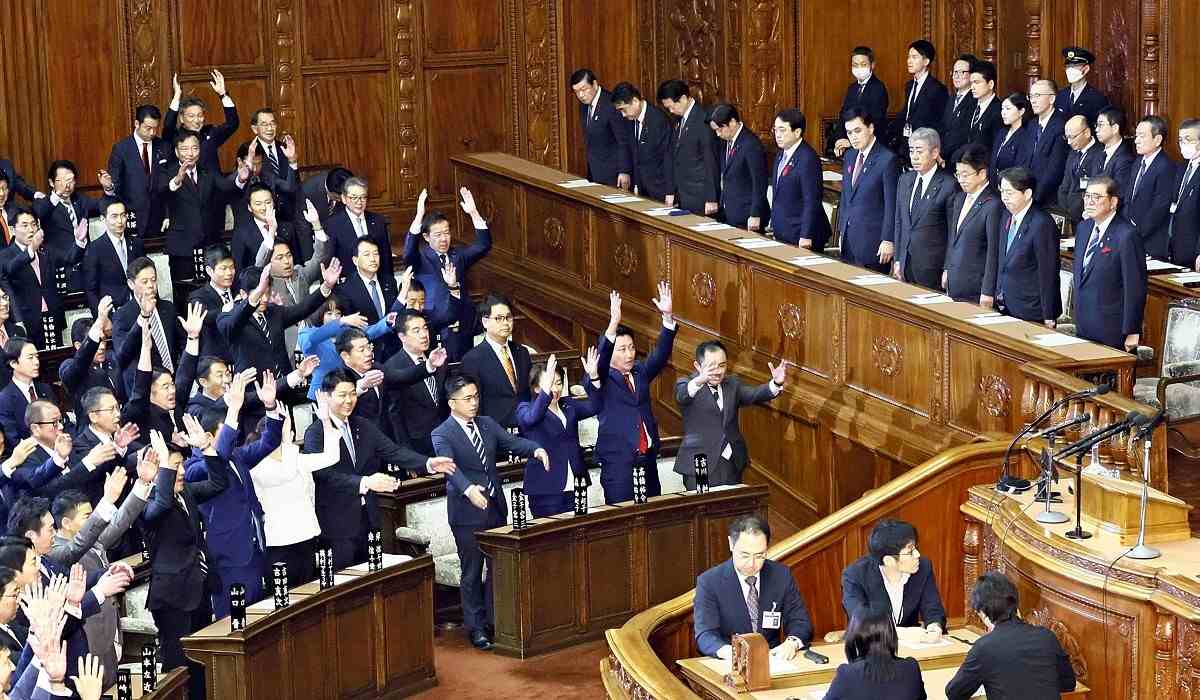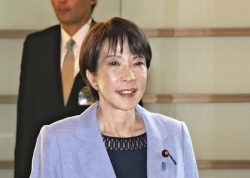Ishiba Dissolves Lower House, Teeing Up Election Campaign / Opposition Leaders Debate Prime Minister

Lower house members celebrate the house’s dissolution at the Diet on Wednesday.
20:00 JST, October 9, 2024
The House of Representatives was dissolved at a plenary session on Wednesday afternoon, setting the stage for a lower house election that will see official campaigning kick off on Tuesday and voting on Oct. 27.
The government officially decided on the schedule for the 50th lower house election at an extraordinary Cabinet meeting later in the day.
With the lower house election schedule set, the ruling and opposition parties have effectively entered the campaign period. The main issues for the race are the economy, including measures to combat rising prices, and political reform in response to the political funds scandal involving LDP factions.
Before the extraordinary Cabinet meeting on Wednesday morning, at which the government decided to dissolve the lower house, Prime Minister Shigeru Ishiba told reporters at the Prime Minister’s Office, “I’ll go into the election wholeheartedly, so that I may gain the confidence of my administration.”
Also on Wednesday, Ishiba held one-on-one debates with the leaders of the opposition parties, including Constitutional Democratic Party of Japan leader Yoshihiko Noda.

Prime Minister Shigeru Ishiba, left, and Constitutional Democratic Party of Japan leader Yoshihiko Noda, third from right, during a one-on-one Diet debate on Wednesday
The 80-minute debates between Ishiba and the leaders of opposition parties began at 1 p.m., with Noda being the first to speak.
Noda touched on the issue of money in politics, urging the prime minister to “start from the basics of political reform.” He added, “Revising the Political Funds Control Law should start with a ban on donations by corporations and organizations.”
Ishiba only said he “would make efforts to ensure thorough transparency.”
After the one-on-one debates, lower house Speaker Fukushiro Nukaga read out an Imperial rescript that officially dissolved the lower house.
The lower house was dissolved eight days after Ishiba assumed the premiership, for the fastest such move in the postwar period. Voting and ballot-counting for the lower house election will be held 26 days after Ishiba took office, another postwar record.
The lower house election will be the first since October 2021, when one was held under the administration of then Prime Minister Fumio Kishida. It will also be the first election to be held since single-seat constituencies were rezoned under the “plus 10, minus 10” plan, in which 10 new constituencies were created while 10 others were eliminated.
Ruling and opposition parties will contest a total of 465 lower house seats — 289 in single-seat constituencies and 176 in proportional representation. Prior to the dissolution, the Liberal Democratic Party and its coalition partner Komeito held 290 seats, with 258 for the LDP and 32 for Komeito. The LDP figure includes those who will not be endorsed for the official party ticket in the upcoming election.
The question is whether the LDP will be able to secure a majority of 233 seats on its own, or whether it will need help from Komeito.
The leaders of the CDPJ, the Japan Innovation Party, the Japanese Communist Party and the Democratic Party for the People jointly submitted to the lower house a no-confidence motion against the Ishiba Cabinet in the afternoon. However, the motion was rendered void when Nukaga read out the Imperial rescript dissolving the lower house.
The CDPJ, the largest opposition party is aiming to push the ruling parties below a majority. The CDPJ is also hoping to arrange with other opposition parties to field only one candidate among themselves in single-seat constituencies where there are LDP members tainted by the political funds scandal. However, the party has not made much progress in coordinating with other opposition parties.
Related Tags
"Politics" POPULAR ARTICLE
-

Japan to Support Central Asian Logistics Route That Bypasses Russia, Plan to Be Part of Upcoming Summit in Tokyo
-

Japan to Tighten Screening of Foreigners’ Residential Status by Providing Information of Nonpayment of Taxes
-

Chinese, Russian Bombers Flew Unusual Path by Heading Toward Tokyo; Move Likely Meant to Intimidate Japan
-

Japan Plans National Database to Track Foreign Ownership of Real Estate, Land as It Weighs New Rules
-

Up to 199,000 Deaths Estimated From Mega-Tsunami; Most Recent Occurrence Took Place in 17th Century
JN ACCESS RANKING
-

Tokyo Economic Security Forum to Hold Inaugural Meeting Amid Tense Global Environment
-

Keidanren Chairman Yoshinobu Tsutsui Visits Kashiwazaki-Kariwa Nuclear Power Plant; Inspects New Emergency Safety System
-

Imports of Rare Earths from China Facing Delays, May Be Caused by Deterioration of Japan-China Relations
-

University of Tokyo Professor Discusses Japanese Economic Security in Interview Ahead of Forum
-

Japan Pulls out of Vietnam Nuclear Project, Complicating Hanoi’s Power Plans























